Leopard Geckos are easily one of the most beloved types of reptiles. They are friendly, docile, and fairly easy to take care of. They are especially attractive among lizards, and even reptile-haters often find them to be irresistibly cute.
There are also TONS of different types of leopard geckos (most commonly called morphs), so every reptile owner is sure to find a variation that they love.
…but what are morphs?
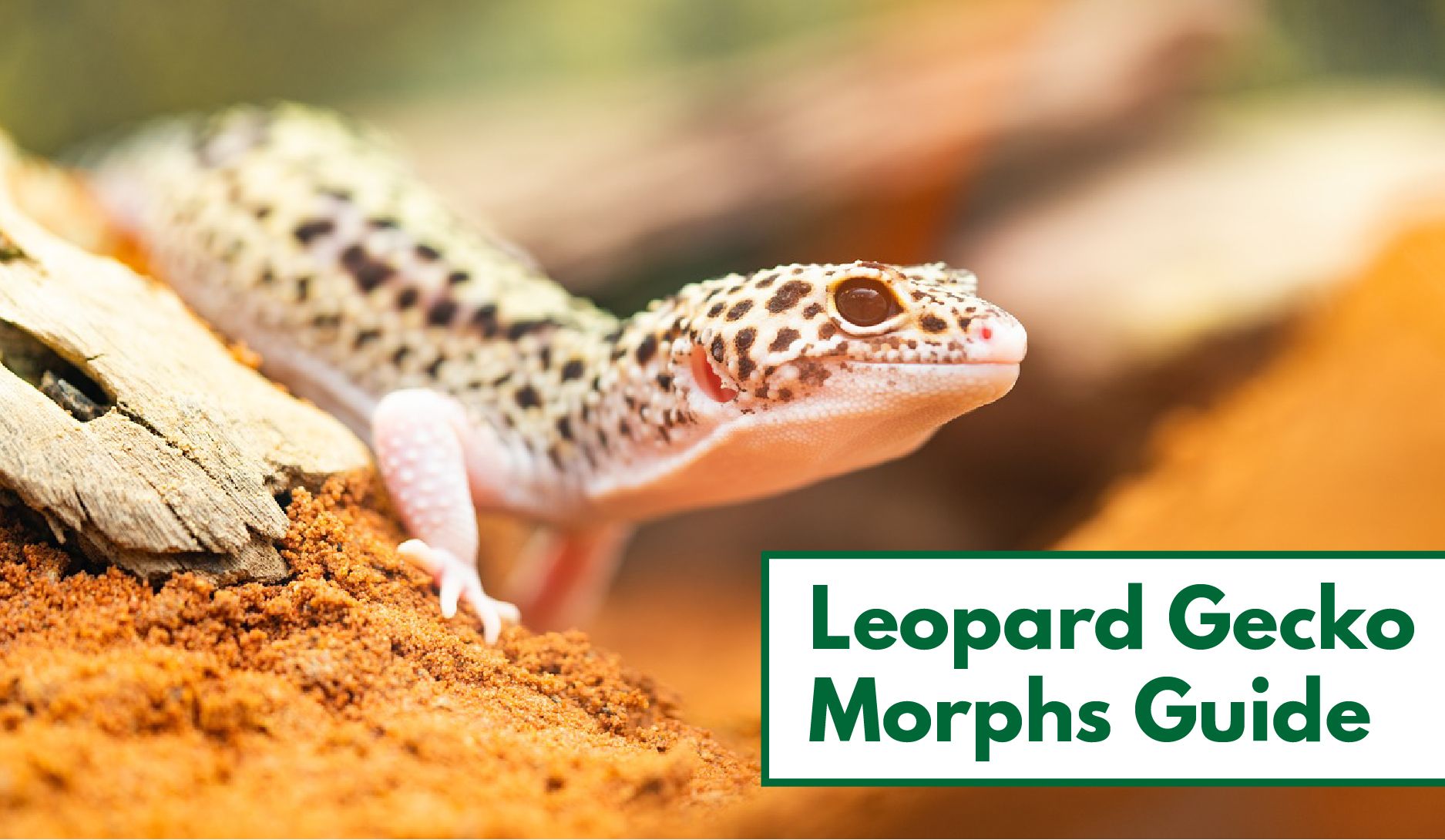
A “leopard gecko morph” is simply a variation in size, coloring, pattern, or other physical features of a leopard gecko. Some morphs are caused by random mutations. Through selective breeding, though, a large (and growing) number of new leopard gecko morphs have been created.
This guide will explore many of the existing leopard gecko morphs, and even a couple that are still being developed. Note that there are many varieties and combinations of leopard gecko morphs, and the potential for still more is practically endless.
Thinking about getting a Leopard Gecko? Check out our step-by-step Leopard Gecko Setup Guide for everything you need to know about keeping these amazing lizards!
Quick Navigation
Morph Terminology
Before we get into the different types of morphs out there, it’s a good idea to have a general understanding of the vocabulary you’ll come across as you learn about and shop for leopard geckos. Reptile genetics (and genetics in general) is a very complex area of study, so keep in mind that these are very simple and basic definitions.
- Genetic Traits: Characteristic, such as eye color or size, that are determined by genetics.
- Recessive Traits: These are traits that come from a recessive gene. In order for recessive traits to be expressed in offspring, they must be passed on from both parents.
- Dominant traits: Dominant traits show up even when only one parent has the dominant gene. When one parent carries a recessive gene and the other carries a dominant gene, the dominant characteristic will typically show up in the offspring.
- Co-Dominant Traits: This describes an instance where an offspring displays expressions of two different but equally dominant traits.
- Phenotype: A word describing an organism’s observable characteristics.
- Genotype: This pertains to the organism’s genetic makeup.
- Line Bred: This is when geckos with particular characteristics are bred with one another with the goal of producing offspring with the same (or improved) traits. Line bred traits are also referred to as polygenic traits.
- Out-Crossing: This refers to the breeding of reptiles displaying different characteristics. This is generally done for two reasons. First, to minimize the risk of genetic defects through diversification. It is also done in hopes of introducing a new trait or having a certain outcome as far as appearance of the offspring.
- Homozygous: Homozygous leopard geckos carry two copies of the same trait, one from each parent.
- Heterozygous: Heterozygous varieties carry one copy of a normal or wild trait, and one copy of a recessive or designer trait.
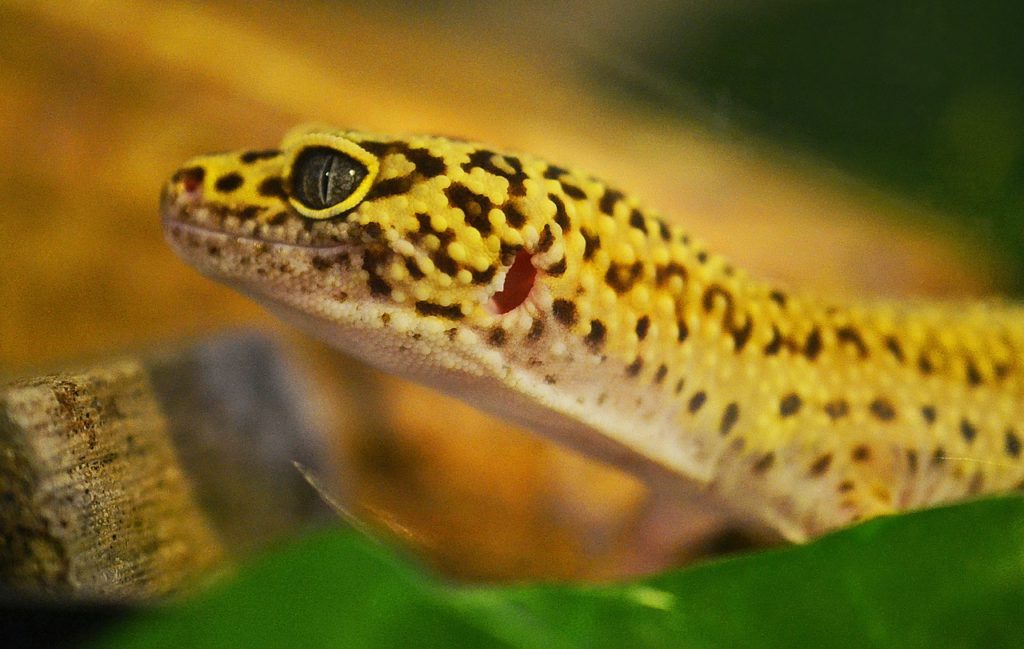
Types of Leopard Gecko Morphs
Since breeders continue to develop new variations on leopard gecko characteristics, the list of morphs and morph combinations is ever-expanding.
If you’re shopping for a leopard gecko as your new pet, know that prices can vary wildly depending on the characteristics of the lizard in question.
Here are just few morph categories that we will cover in this guide:
- Normal & High Yellows
- Albino Morphs
- Striped Morphs
- Hypo/Hyper Melanistic Morphs
- Blizzard Morphs
- Patternless Morphs
- and tons of others!
Some morphs may only be available from select breeders, and you may even find some inconsistencies in the ways different breeders classify and name certain leopard gecko morphs.
This guide should help you to become more informed about leopard gecko morphs, whether you’re just curious about different reptile varieties or you’re in the market for a leo of your own.
Normal Leopard Geckos
“Normal” Leopard Geckos are the types you’ll most typically find at Petco or other chain pet stores. They generally cost a bit less then the rarer morphs, but are awesome nonetheless!
Normal

Sometimes called Wild Type, these are the types of leopard geckos found in the wild. These lizards display the signature yellow bodies and black spots for which leopard geckos are named. These are generally the least expensive and most readily available type of leopard gecko
High Yellow

This is a Normal variant with more yellow coloration than usual, and with fewer black spots. Once again, these are fairly common and usually not too expensive (don’t worry, we will get to those!).
Albino Morphs
Albinism in leopard geckos is a bit different than the albinism seen in other animals. Albinism is typically caused by a lack of the enzyme tyrosinase, which prevents the animal from producing melanin.
Albino leopard geckos produce a very small amount of melanin, and do not have this enzyme deficiency. (Technically speaking, this makes them amelanistic rather than truly albino). So-called albino leopard geckos usually display some light coloration.
Mack Snow
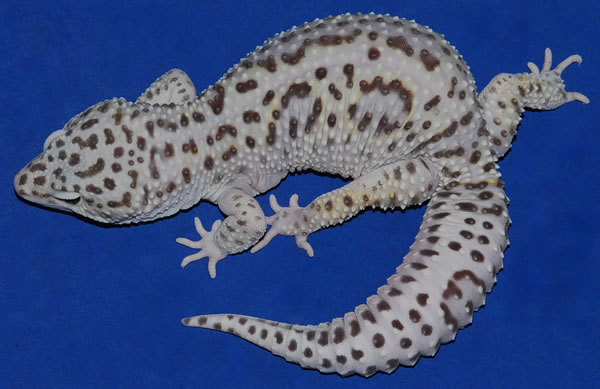
Mack Snow leopard geckos are pale with black bands. They are usually white as hatchlings, but develop some light coloring as they mature.
Super Snow

Super Snows are homozygous, and are usually the result of breeding two Mack Snow morphs together. Heavy speckling and white coloring are the signature features of this morph, along with solid color eyes.
Tremper or Texas Albino
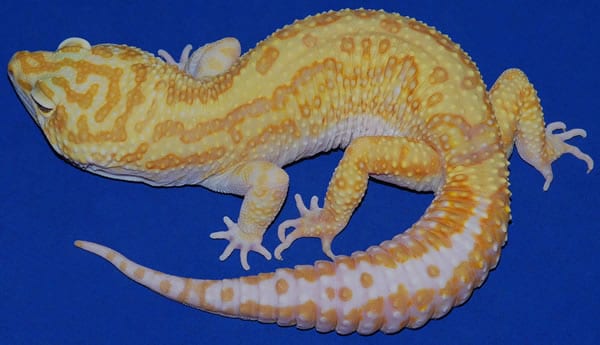
Tremper Albinos were one of the first albino leopard gecko strains to be discovered. They mostly display silver eyes with visible red veins and can come in a range of colors including brown, yellow, pink, and orange.
Bell Albino
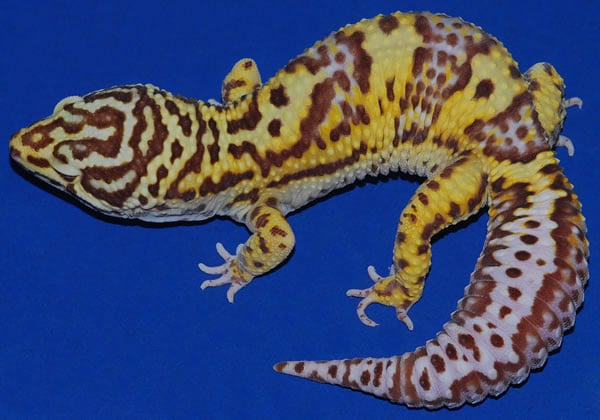
Some people may call this particular morph the Florida Albino. They are often lavender in color, with brown spots. One of the most distinguishing characteristic of the Bell Albino is its light pink eyes.
Rainwater Albino

Rainwaters are generally smaller and lighter in color than other albino morphs. As hatchlings, they most often display yellow bodies and pink bands. In addition, rainwaters have darker eyes than other albinos. Rainwaters are sometimes called Las Vegas Geckos.
Striped Leopard Gecko Morphs
Striped morphs display stripes that run down the length of their bodies. (Stripes are not to be confused with bands, which are rings that wrap around the width of the body).
Bold Stripe
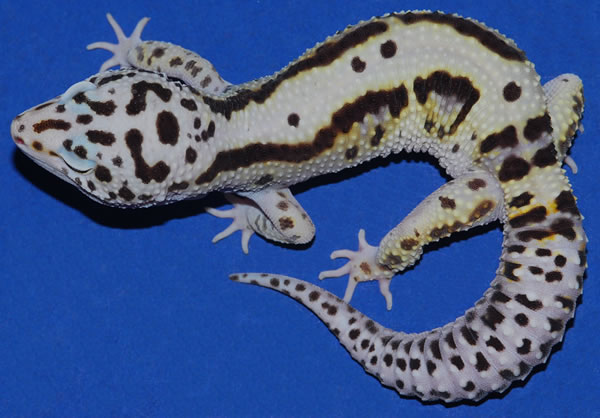
Bold Stripes display patterns and stripes that run down the sides of their bodies, rather than in the middle of their back. This morph is highly desired and can often go for $200-$300, sometimes more!
Red Stripe
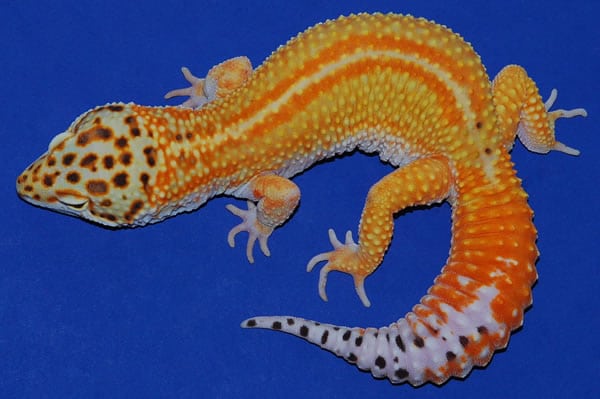
The Red Stripe leopard gecko has two red (or reddish) colored stripes down each side of its back. These stripes usually show up around 6 months of age. Before that, the juvenile gecko will display some brown coloration where the stripes will eventually be.
Raining Red Stripe
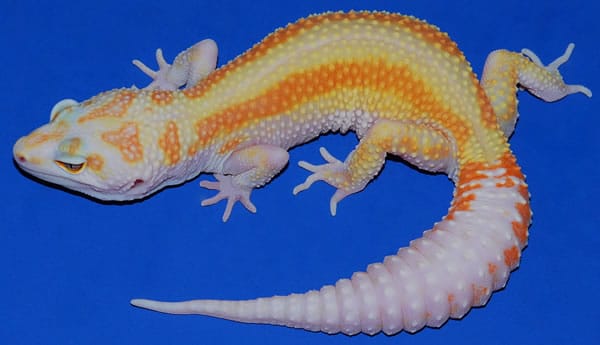
The Raining Red Stripe morph is the result of crossing Rainwater Albinos with Red Stripe and Bold Stripe varieties. These morphs look like much like a Rainwater Albino with red stripes.
Much like their pther striped counterparts, Raining Red Stripes can get pretty pricy – the one pictured above is valued at over $600!
Giant Leopard Geckos
The name of this category of morphs is pretty self-explanatory, as Giants are bigger than the average leopard gecko. Not all large leopard geckos are necessarily true Giant varieties, though.
Super Giant

The Super Giant is the homozygous version of the Giant and, as you may have guessed, is so named because it’s even bigger than regular Giant morphs.
Godzilla Super Giant

As indicated by the name, this is the biggest giant leopard gecko variety. They are limited in availability and often hard to find.
The super giant featured above, nicknamed “Godzilla”, weight in at 142g and is listed for over $1,200. Talk about a true monster!
Hypo/Hyper Melanistic Morphs
Hypo Melanistic (or Hypo) morphs have less melanin than others and no more than 10 spots on their bodies. This does not include spots that may appear on the head or tail. Hypermelanistic (or Hyper) morphs have more melanin, which gives them a darker pigmentation.
Super Hypo

Super Hypos are hypomelanistic leopard geckos that are yellow with no spots on their bodies at all. As you can see from the image above, Super Hypos often have spots on their head (unlike Baldies shown below).
Baldy
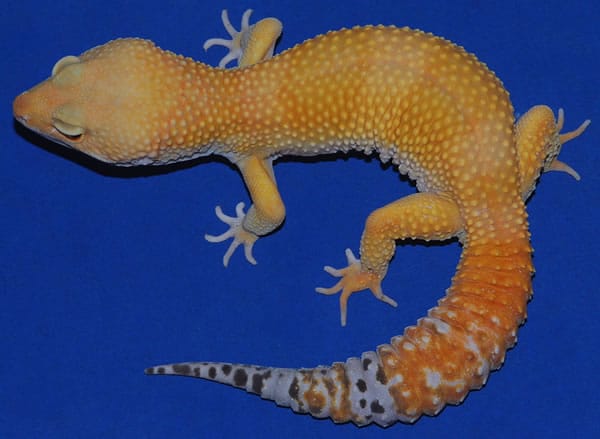
Baldies are Super Hypos with no spots on their heads. They generally start around $150 and get more expensive depending on how much of a redish tone they have. Blood Super Hypes can fetch upwards of $750!
Hybino
Hybinos, or Hypo-Albinos, are created by combining a Super Hypo and any of the albino strains. They are usually solid yellow or orange-yellow colored with eyes that display characteristics of an albino variety. Some breeders may refer to these as Sunglow morphs.
Hypo Ghost – $200
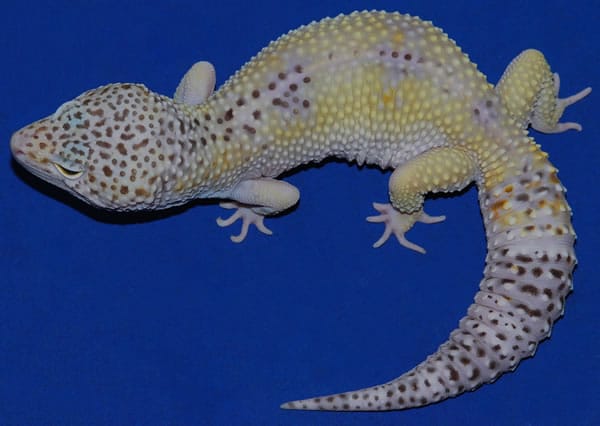
Hypo Ghosts, or simply Ghosts, display very light coloration. This tends to fade even further as they mature. Hypo Ghosts are often difficult to difficult to spot as juveniles since they look so much like Mack Snows.
Melanistic Leopard Geckos
To be considered Melanistic, a leopard gecko must be all black. Though it is reported that a melanistic morph was successfully produced, there are currently no known true Melanistic leopard geckos. However, breeders are actively working on developing them.
The closest morphs currently available are Black Velvets and Black Pearls. One thing is for sure – when Melanistic Leopard Geckos are finally produces, they’re going to fetch incredible prices!
Blizzard Leopard Gecko Morphs
Blizzard gecko variants are devoid of patterns, and instead display a solid color across their entire bodies. Blizzards are generally white or yellow. Darker-colored Blizzards are sometimes called Midnight Blizzards.
Banana Blizzard
Sometimes, bright yellow Blizzard morphs are sold as Banana Blizzards. However, a true Banana Blizzard is really a yellow-colored Patternless.
Blazing Blizzard
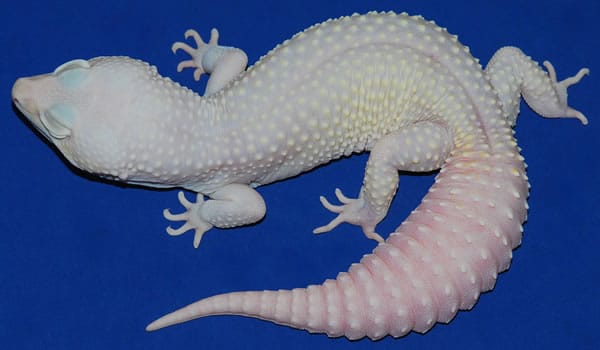
Blazing Blizzards are Blizzard morphs that have been bred with Albino morph varieties. So far, breeders have been successful at creating Rainwater and Tremper Blazing Blizzards.
Blazing Banana Blizzard
Still under development by breeders, the Blazing Banana Blizzard combines Blizzard, Patternless, and Albino traits. The eyes should look like the type of Albino they are bred from, and the body should display traits consistent with the Patternless morph.
Patternless Morphs

Sometimes called Murphy Patternless, these leopard geckos have no discernible spots once they reach adulthood. They are very similar in appearance to Blizzard morphs. Most are purple or gray, though some are greenish or yellow in color. Patternless Albinos are a popular morph combination, as are Carrot Tail Patternless leopard geckos and Patternless Blizzards.
Other Leopard Gecko Morphs
Here are some other awesome types of leopard geckos that don’t fit into the above categories:
Eclipse
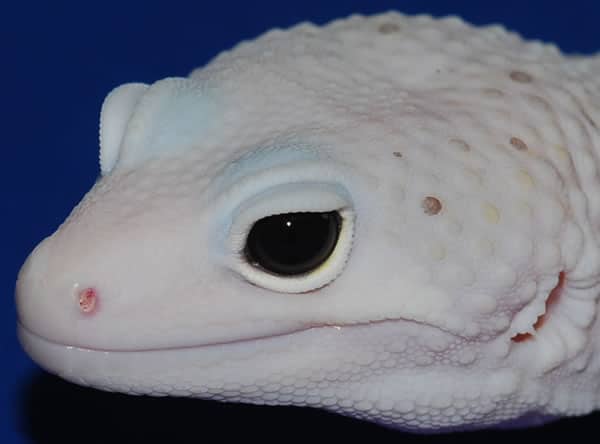
An Eclipse displays solid-colored eyes. This trait is found in Mack Super Snows, Blizzards, and Tremper Eclipses. The Eclipse trait is recessive, so two Eclipse Leopard Geckos can produce Snake Eyed offspring as well.
Snake Eyes
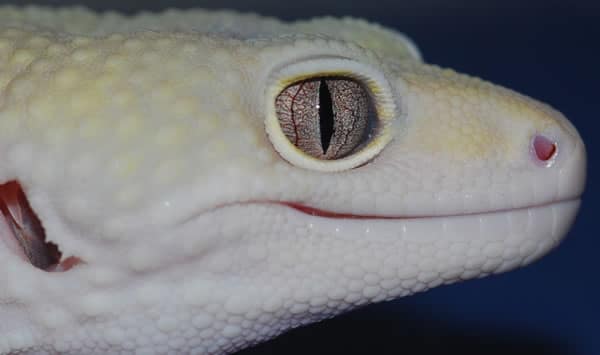
Snake Eye morphs are seen in Blizzards and Tremper Eclipses, and are characterized by having eyes that are not completely solid (resembling, in some cases, snake eyes). Breeders usually list the percentage of Snake Eye a leopard gecko has. This percentage represents how much of the lizard’s eye is solid-colored.
Enigma
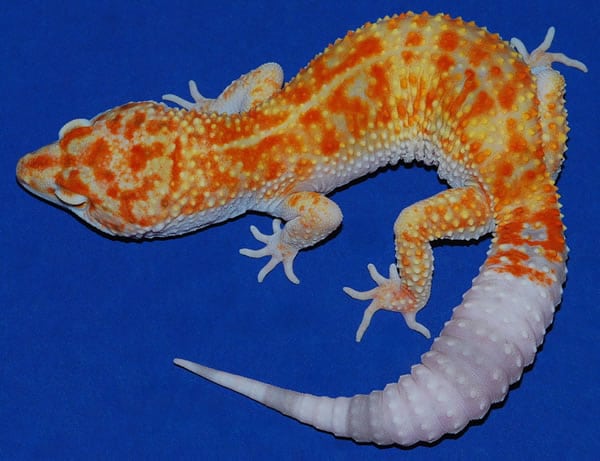
Enigmas have speckled patterns and mostly white tails. Enigmas tend to have blotches rather than defined bands and often become more spotted as they age.
Tangerine

Any Leopard Gecko displaying any shade of orange can be considered a Tangerine. Super Hypo Tangerines, such as the one shown above, tend to fetch higher prices than those with a less intense orange coloration.
Carrot Tail
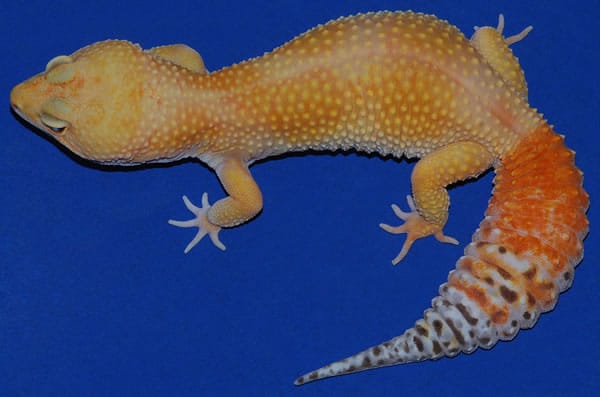
This refers to a leopard gecko thathas an orange tail. Most commonly, Carrot Tails are seen in RAPTORs, Patternless, Tangerines, Hypos, and Albinos. Carrot Tail morphs have recently been reported among Blizzards as well.
Carrot Head
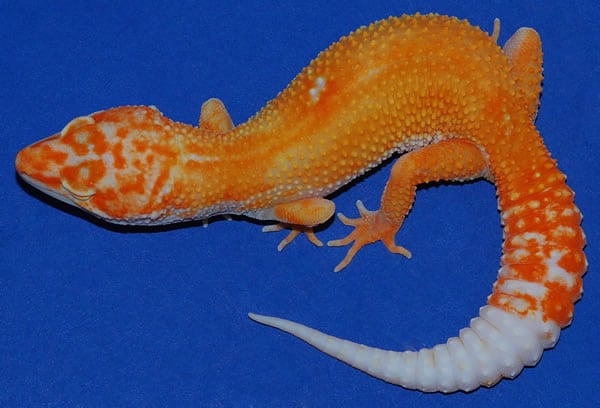
This term is used for leopard geckos with orange heads. Like Carrot Tails, the price of Carrot Head Leopard Gecko often increases as the intensity of the orange hue increases.
Aberrant
Aberrants are characterized by their inconsistent or broken patterns. To be a true Aberrant, the disrupted pattern must be displayed on the tail or the body, but not on both. Aberrants are most commonly found among Normal and Mack Snow morphs.
Jungle
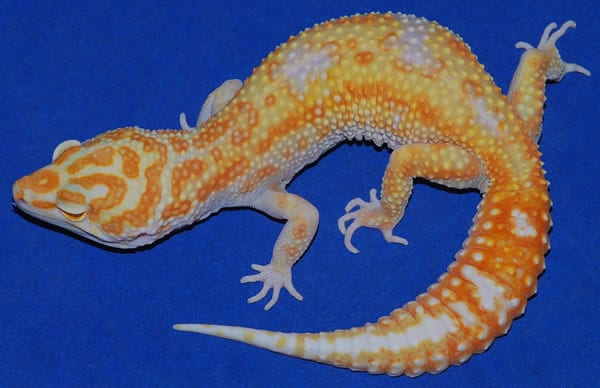
A Jungle leopard gecko is much like an Aberrant, except that the broken pattern appears on both the tail and the body. The gecko shown above is actually considered Carrot Head, Carrot Tail, and Jungle Tremper Albino!
Marble Eye

Rare among leopard gecko morphs, the Marble Eye trait is so named because it describes reptiles whose eyes have a 3-dimensional, marble-like appearance.
Lavender
This name is generally applied to any leopard gecko with lavender or violet color variations on its body. This is a particularly difficult morph to produce; most baby Lavenders begin to lose their signature coloration as they get older.
Halloween Mask

Sometimes called Halloween Geckos, leopard geckos with this trait display bold markings on their heads and bodies. These markings are usually very dark and striking.
RAPTOR

This is an acronym for Red-eye Albino Patternless Tremper ORange. RAPTORs have red eyes and orange bodies. This morph is the result of combining Eclipse, Patternless Stripe, and Tremper Albino morphs. Reverse Stripe, Carrot Head, and APTOR morphs were all created during attempts to produce the RAPTOR morph.
APTOR
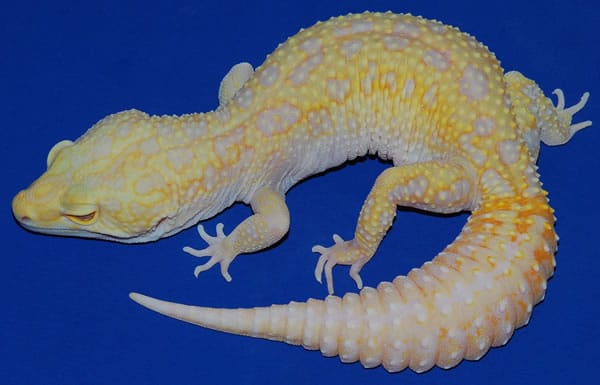
APTOR, or Albino Patternless Tremper ORange, is very similar to the RAPTOR. It does not, however, have red eyes.
Diablo Blanco
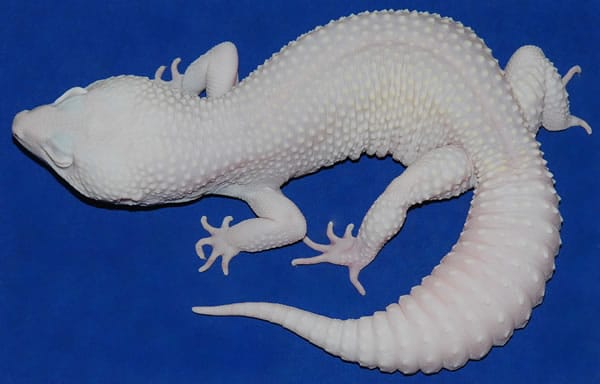
This combination morph is a blend of Blizzard and RAPTOR traits. They have white bodies and solid red eyes. A solid white gecko might not sound like the most exiting morph at first – as you can see, though, these guys are visually striking!
Dreamsicle
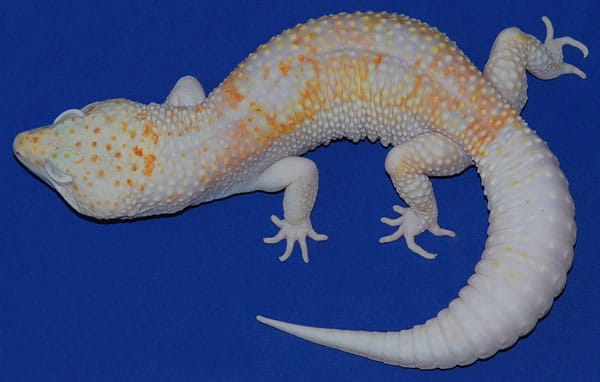
The Dreamsicle morph comes from combining the Enigma, RAPTOR, and Mack Snow morphs. They generally exhibit orange and while patterns (hence the “dreamsicle” name).
Nova
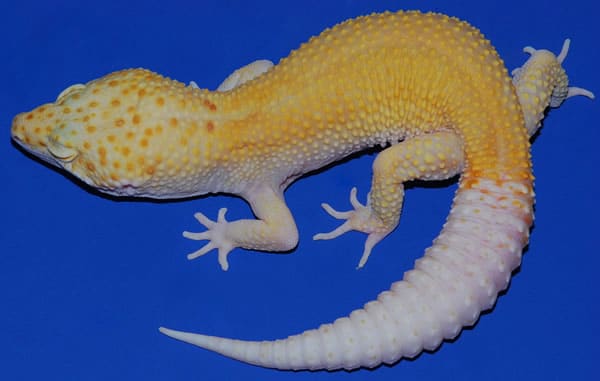
Novas are a combination of Enigma and RAPTOR morphs.
Buying Leopard Geckos
When purchasing any kind of animal, it’s incredibly important to be discerning about who you buy from. Because selective breeding of leopard geckos has become such a popular hobby, some people who have jumped on the breeding bandwagon don’t have the experience or expertise they should. Irresponsible breeding can result in defects, disorders, and even death in leopard geckos.
What to Look for in a Good Breeder
Be sure to research any breeder or pet store you are considering making a purchase from. Here are some things to look for.
1. Expertise
A good breeder will know their stuff when it comes to leopard gecko genetics and morph varieties. They should be knowledgeable and able to answer your questions thoroughly and accurately.
2. Communication
Not only should a breeder be willing and able to answer your questions before you buy, they should be available to you even after you make a purchase. Find someone who encourages you to reach out if you have any questions once you’ve brought your new pet home.
3. Attitude
If a breeder is defensive when asked questions or is otherwise unpleasant to deal with, it could be a red flag. Consider looking elsewhere. Another thing to look for is a breeder that seems to genuinely care for the animals he or she is working with.
4. Reputation
Good breeders generally have good reputations. Look for reviews or testimonials by past customers. You can also find reptile communities in your local area or online. These groups often have great insights about different breeders.
Our Recommended Breeder
If you’re looking for an awesome and unique Leopard Gecko, we HIGHLY recommend checking out GeckosEtc.com. All of the geckos in this post are for sale on their site. No other breeder has the selection, quality, reputation, and customer service that you will find with GeckosEtc.
Note: Reptile Advisor is not affiliated with GeckosEtc in any way – we are just huge fans!
If you’re thinking about purchasing a leopard gecko of your own, check out our step-by-step setup leopard gecko setup guide.
I’m new into leapord geckos. I have a gecko I bought for my daughter, were looking for another but we can’t figure out what type or morph he is. Is there anyone who may be able to help? Thank you so much.
sure! can you send me a picture?
Can I send you picture of my two leopard gecko too? I’ve been wondering for a long time for my oldest one!
Thanks 🙂
Soo I just got a Leopard Gecko and it doesn’t look like any of these how can I tell what it is
Hi Lily! If you send a picture over to our email, we will take a look and see if we recognize the morph. Our email is info@reptileadvisor.com.
Hello Grace
Please can I have a contact where I can supply my Geckos
I am based in East Africa
I breed and personally have been trying to build a few dream morphs for myself. A bold tangerine tremper(basically bandits with high contrast tempers), and a super snow patternless tremper albino(my knock of a Diablo blanco without the cranky little blizzards gene in there), and lastly a super giant sunglow raptor. Which I’m getting there..I like big solid color geckos or ones with bold swirling patterns
Hi I just got a leopard gecko and I have no clue what morph he is if I could send you a picture that would be awesome.
Hello my brother got a Leopard Gecko a few weeks back and we can’t determine what kind it is?
Hey there! Love this site and will be contacting the favorite choice of breeder on this site in the near future. I’d like to send pics of my 2 leopard geckos to see if you can determine what morph they are. They were rehomed to me and the man who rehomed them, didn’t know. I was told one of them could be a “visual hypo” but I’m not sure.
Hi Tresha, go ahead and send a picture to info@reptileadvisor.com and we will take a look!
I’m not sure what morphs my leopard geckos are. Could anyone help me out with this?
Hi Bryanne, go ahead and send a picture to info@reptileadvisor.com and we will take a look!
I have 7 baby leopard geckos and 1 adult that I have been trying to figure out what morphs they are. I would attach pics if I knew how. Lol
HELP PLEASE!
Hi, I am new to leopard geckos and I have a question I haven’t been able to find an answer to and I’m hoping someone can! I bought a very young juvenile leopard gecko back in February. He was growing very well no shedding problems, and had a beautiful yellow hue. He was the normal Wild type gecko , yellow with the black bands. Well about 2 weeks ago he started to change. He got very dark in color, almost a dark brown color everywhere and was shedding quite a lot. Then about 2 days ago he looks like the Mack snow gecko in color. Can anyone tell me what’s going on?
So I got my leopard gecko from petsmart (they said he was a common leopard gecko), and he’s an older juvenile (he’s around 6 and 1/2 inches in length). And he doesn’t really look like the other common leopard geckos I have seen. Can I send you a few pics to see what kind of morph he is?
what I meant to say was that can anyone help me with this
Hi Spencer, go ahead and send a picture to info@reptileadvisor.com and we will take a look!
I have a new baby that just hatch but couldnt figure it out what morph izzit coz the patern and the colour really amazing…i aready search on google but there is no info and pic ablut my baby gecko morph…please help me to figure it out tq
Hi Bryan, go ahead and send a picture to info@reptileadvisor.com and we will take a look!
So I am looking at getting a murphy patternless, Not that it matters, but I was wondering how rare they are.
I have a leopard gecko and can’t tell what kind of morph it is …it’s starting to shed and I rescued her so I have no info on what her parents are or anything
Hello, I’m new to owning a leopard gecko and I’m interesting in learning what Morpheus from the pictures above I think he might be a Halloween leopard gecko or possibly the Bell albino but he looks much more like the Halloween ones me I was wondering if anybody would be able to help me completely decide which one it is I guess to say or if somebody could pitch in their idea I also can’t tell if he has the marble eyes or not his eyes are very pretty and they’re very different but they could just be regular I’m not quite sure
Hi I have a leopard gecko that has marble eyes! But looks like a mix of normal and lavender.. do you have a gmail that I can send a picture too? And also are marble eyes rare?
My boyfriend and I got another leopard gecko I went through to read these and her eyes are light but I didn’t see her eye color up there. We think she’s a bell albino because she doesn’t look like our other 3 and really stand out, We can’t tell what she is.